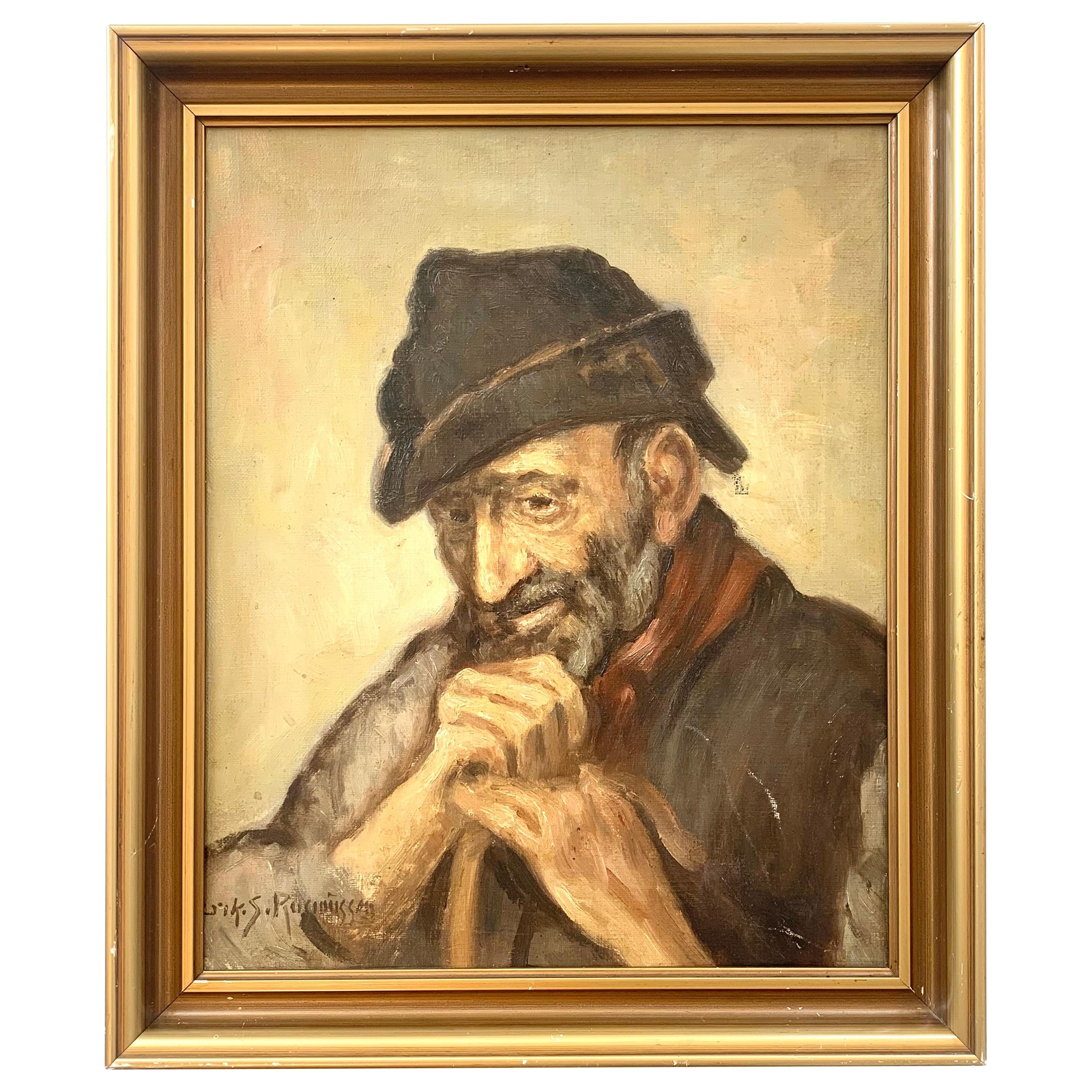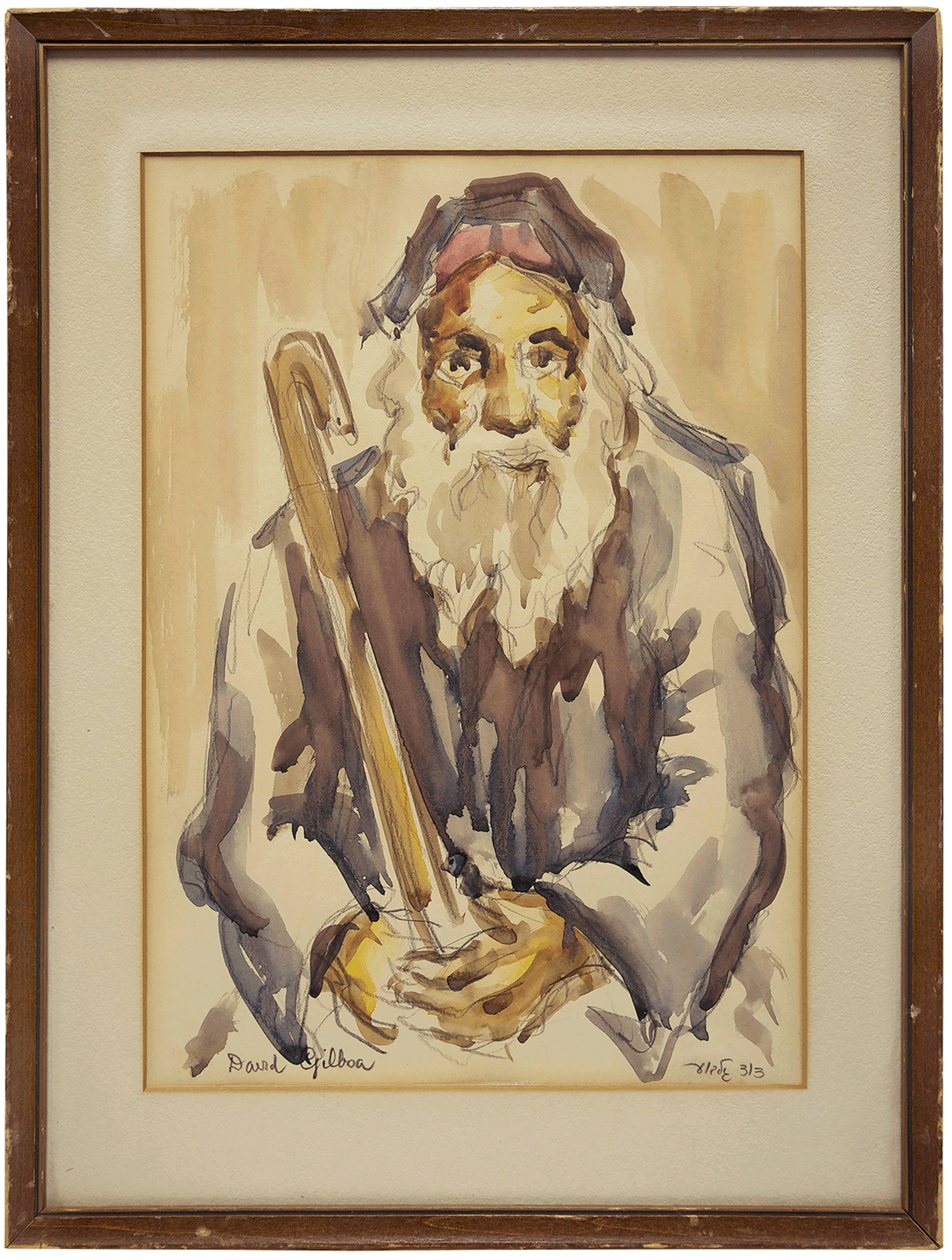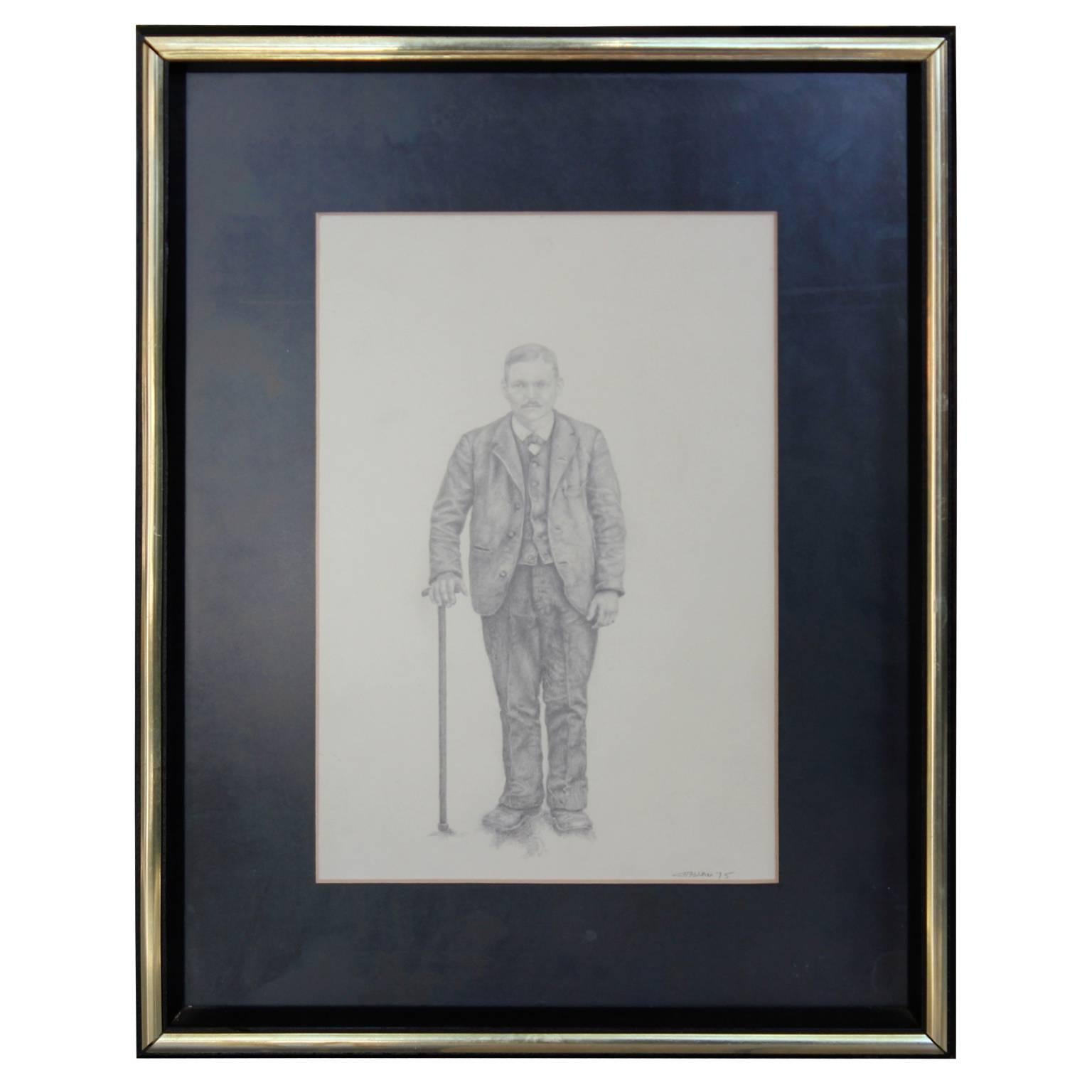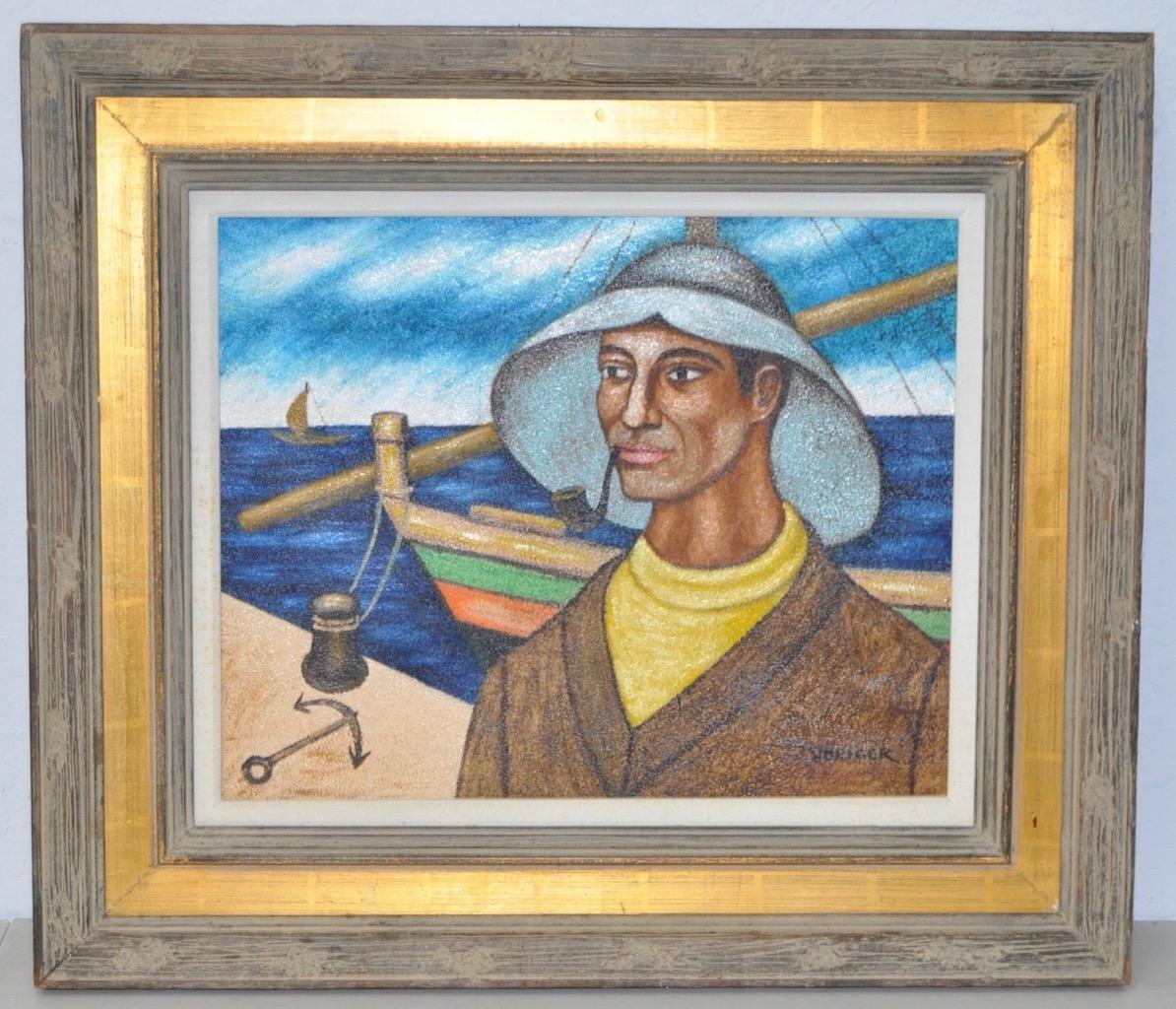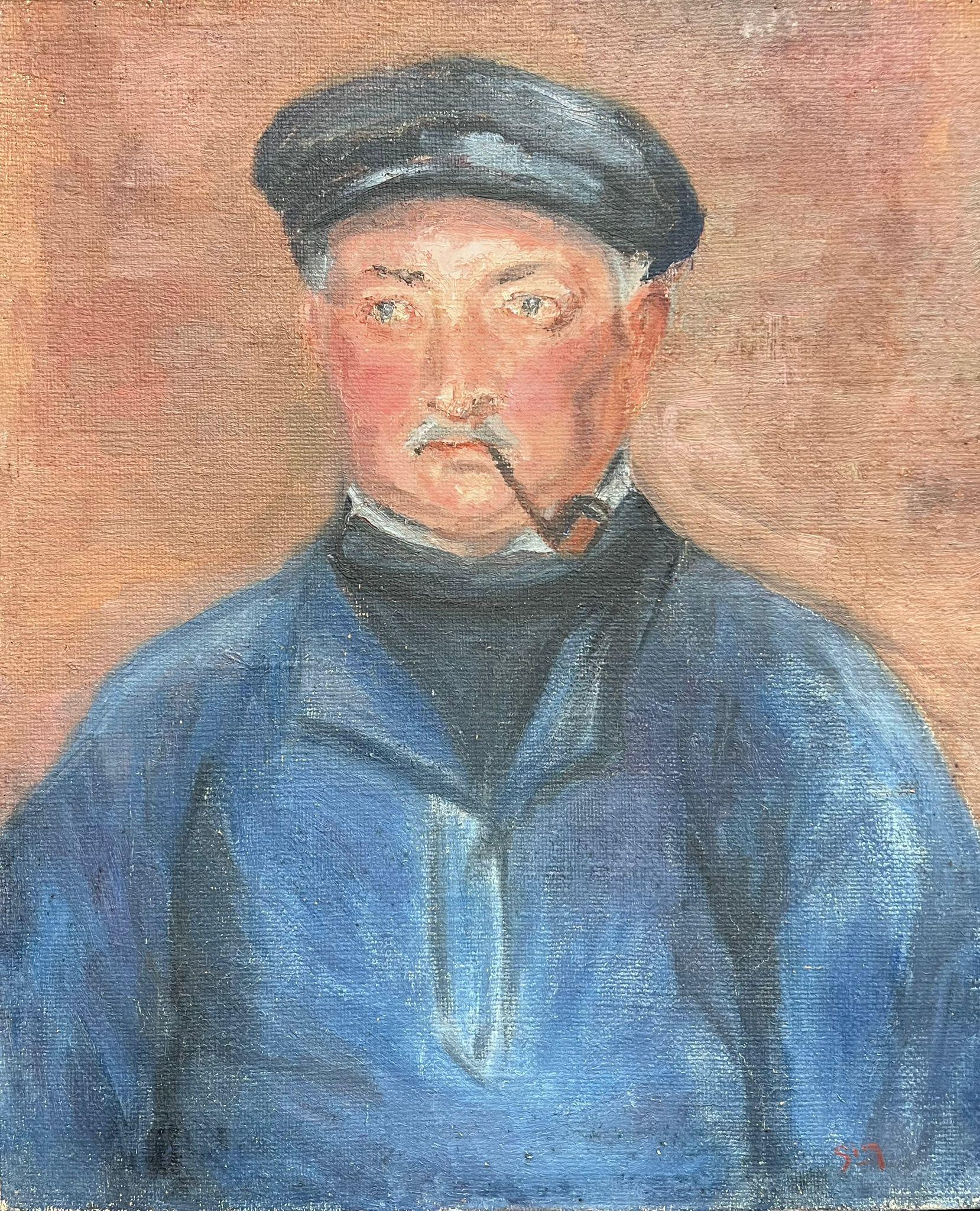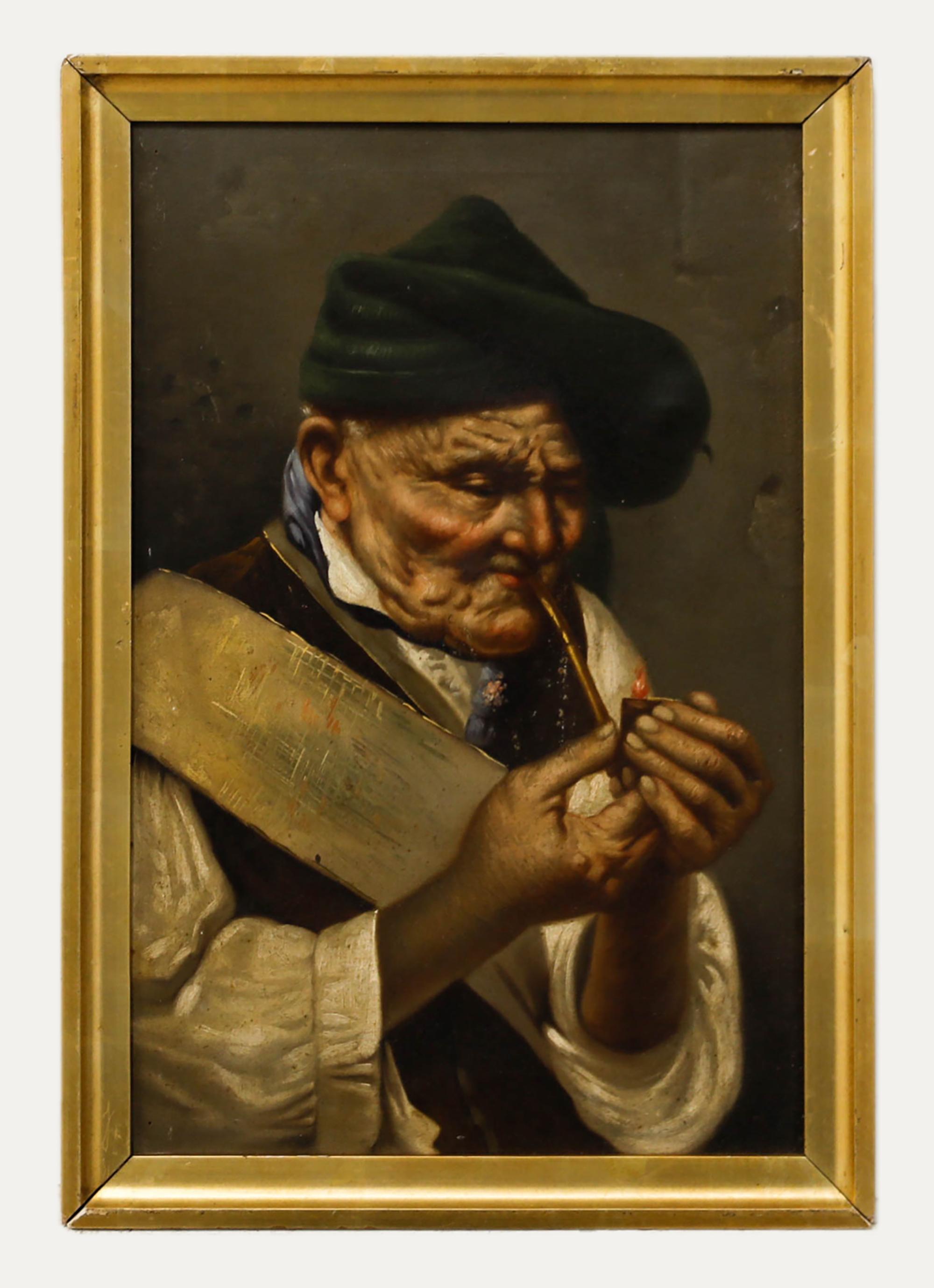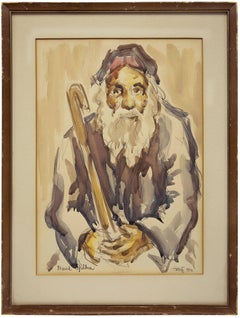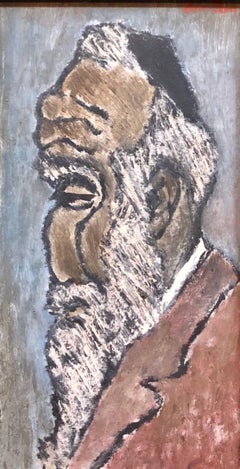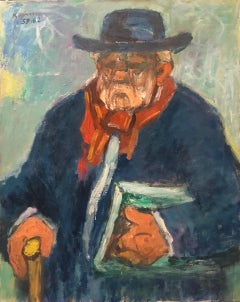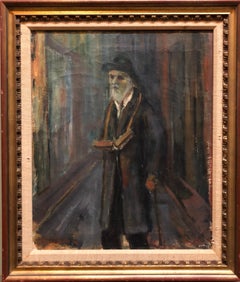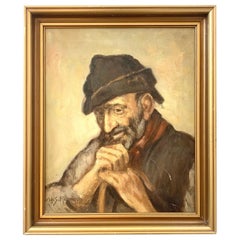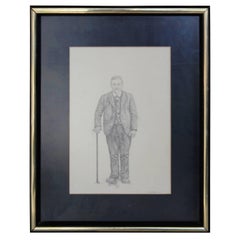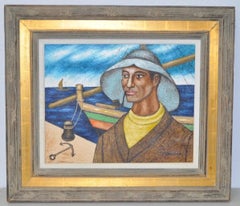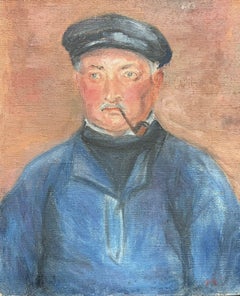Items Similar to Portrait of an Old Man with Cane, Important Chicago Modernist WPA Artist
Want more images or videos?
Request additional images or videos from the seller
1 of 10
William S. SchwartzPortrait of an Old Man with Cane, Important Chicago Modernist WPA Artistc. 1940
c. 1940
$6,500
£4,934.69
€5,644.23
CA$9,081.44
A$10,100.55
CHF 5,274.19
MX$122,912.91
NOK 67,359.47
SEK 63,171.30
DKK 42,125.06
Shipping
Retrieving quote...The 1stDibs Promise:
Authenticity Guarantee,
Money-Back Guarantee,
24-Hour Cancellation
About the Item
Portrait of an Old Man with Cane, by American artist William S. Schwartz, c. 1940, gouache painting, signed l.l, framed.
William S. Schwartz (February 23, 1896 – February 10, 1977) was an American artist who lived and worked in Chicago.
Schwartz was born in Smorgon in Belarus, then in the Russian Empire in 1896. His parents were Samuel Schwartz and Tauba Reznikoff. At the age of thirteen, he moved to the nearby city of Vilna to attend art school. Four years later, he emigrated to the United States and eventually enrolled in the School of the Art Institute of Chicago. After graduating, he put his art career on hold to concentrate on a budding career as an opera singer. When Schwartz returned to painting, he distinguished himself with dreamy, symbolist works and abstractions that tended to bewilder viewers. He also scandalized conservative audiences with numerous lithographs of nude women. During the Great Depression, Schwartz became an artist on the Federal Art Project (WPA) payroll painting murals. He was one of the seven WPA artists who contributed to a mural at Riccardo's, Schwartz (Music), Malvin Albright (Sculpture), Ivan Alrbight (Drama), Aaron Bohrod (Architecture), Rudolph Weisenborn (Literature), Vincent D’Agostino (Painting), and Ric Riccardo (Dance). In 2002 Chicago philanthropist Seymour H. Persky acquired the murals for his personal collection.
Through the WPA, Schwarz received commissions to produce murals in post offices and public spaces. He created his “Americana Series,” a group of four paintings featuring poets, painters, composers and scientists. His Composersdepicts four contemporary musicians, among them, Victor Herbert. The mural was discovered at Glencoe Public Library, IL, in 2007, and include: Americana No. 1 Poets: Mark Twain, Walt Whitman and Edgar Allen Poe; Americana No. 2 Painters: Saint Gaudens, Bellows, Sargent, Innes, Whistler and Homer; Americana No. 3 Composers: Herbert, DeKoven, Chadwick, MacDowel; Americana No. 4 Scientists: Thomas Alva Edison, Steinmetz, Alexander Graham Bell, and Morse. Working under the supervision of Increase Robinson in Chicago, he painted Regionalist works showing the countryside and small-town American life. It was not until the early 1940s that Schwartz returned to painting the esoteric imagery for which he had become known. Greatly influenced by European surrealism, Schwartz painted strange biomorphic forms and apocalyptic scenes in many of his works.
He became a well-known figure in Chicago, mostly due to his memorable handlebar mustache and eccentric persona. He was also one of a group of prominent Chicago artists—including Ivan Albright, Malvin Albright, and Aaron Bohrod—that hung out at Riccardo's Restaurant and Gallery during the 1940s and 1950s. Drawing from the fauve spirit and utilizing elements of cubism, constructivism, and surrealism, Schwartz considered himself a “romantic modernist,” refusing to bend to the whims of what was in vogue. In the mid-1920s, Schwartz started painting what many consider his greatest achievement, a surrealist series called the “Symphonic Forms.” While not documented, it was widely accepted that Schwartz attended the Wassily Kandinsky solo retrospective at The Art Institute in Chicago in 1922.In his final years, Schwartz returned exclusively to painting abstracts; these paintings are considered among his best work. Schwartz began suffering from Alzheimer's disease around 1970 and died in Chicago on February 10, 1977. The Art Institute of Chicago and the Joslyn Art Museum in Omaha have several of Schwartz’s works in their permanent collections.
- Creator:William S. Schwartz (1896-1977, American, Russian)
- Creation Year:c. 1940
- Dimensions:Height: 21 in (53.34 cm)Width: 17 in (43.18 cm)Depth: 2 in (5.08 cm)
- Medium:
- Movement & Style:
- Period:
- Condition:
- Gallery Location:Surfside, FL
- Reference Number:1stDibs: LU38211300372
About the Seller
4.9
Platinum Seller
Premium sellers with a 4.7+ rating and 24-hour response times
Established in 1995
1stDibs seller since 2014
1,784 sales on 1stDibs
Typical response time: <1 hour
- ShippingRetrieving quote...Shipping from: Surfside, FL
- Return Policy
Authenticity Guarantee
In the unlikely event there’s an issue with an item’s authenticity, contact us within 1 year for a full refund. DetailsMoney-Back Guarantee
If your item is not as described, is damaged in transit, or does not arrive, contact us within 7 days for a full refund. Details24-Hour Cancellation
You have a 24-hour grace period in which to reconsider your purchase, with no questions asked.Vetted Professional Sellers
Our world-class sellers must adhere to strict standards for service and quality, maintaining the integrity of our listings.Price-Match Guarantee
If you find that a seller listed the same item for a lower price elsewhere, we’ll match it.Trusted Global Delivery
Our best-in-class carrier network provides specialized shipping options worldwide, including custom delivery.More From This Seller
View AllOld Rabbi Holding a Cane
By David Gilboa
Located in Surfside, FL
David Gilboa (1910-1976). David Gilboa was born in Romania in 1910. He studied at Academy of Fine Art, Bucharest, Romania, during the years of 1927-29. He immigrated to Israel in 193...
Category
20th Century Portrait Drawings and Watercolors
Materials
Watercolor
Modernist Judaica Oil Painting "Old Jew" Jewish Rabbi at Prayer
By Ben-Zion Weinman
Located in Surfside, FL
An oil on board Judaic painting by modern artist Ben-Zion Weinman. It depicts a portrait in profile of an old Jew. The work is signed "Ben-Zion".
Born in 1897, Ben-Zion Weinman celebrated his European Jewish heritage in his visual works as a sculptor, painter, and printmaker. Influenced by Spinoza, Knut Hamsun, and Wladyslaw Reymont, as well as Hebrew literature, Ben-Zion wrote poetry and essays that, like his visual work, attempt to reveal the deep “connection between man and the divine, and between man and earth.”
An emigrant from the Ukraine, he came to the US in 1920. He wrote fairy tales and poems in Hebrew under the name Benzion Weinman, but when he began painting he dropped his last name and hyphenated his first, saying an artist needed only one name.
Ben-Zion was a founding member of “The Ten: An Independent Group” The Ten” a 1930’s avant...
Category
1940s American Modern Figurative Paintings
Materials
Oil, Board
Portrait of a Gentleman, Large Modernist Oil Painting
By Benjamin Kopman
Located in Surfside, FL
BENJAMIN KOPMAN (1887 - 1965)
Painter, Illustrator and printmaker Benjamin Kopman was born in Vitebsk, Russia and emigrated to the United States with his family in 1903. It was a cen...
Category
Mid-20th Century Expressionist Portrait Paintings
Materials
Canvas, Oil
Judaica Oil Painting 1945 Palestine Old Jewish Man Polish Israeli Artist
By Ozer Shabat
Located in Surfside, FL
Ozer Shabat 1978-1901
Ozer Shabbat was an Israeli painter, a resident of Haifa. Belonged to the Palestine Expressionist group of the late 1920s and early 1930s.
Shabbat was born in Wolbrom, Poland. At the end of the First World War he went to Holland for agricultural training in the framework of the HeChalutz movement, prior to his immigration to Palestine. In 1920 he immigrated to Eretz Israel and joined the Hulda group. Later he joined the Merhavia group and there he began painting. Because of his desire to study drawing, he left the group and moved to Jerusalem. In 1921, he wrote articles in the newspaper "HaSadeh" on the subject of agriculture and Dutch cheese.
Ozer Shabath won the first prize in a competition for the design of the Dutch Consulate's Garden in Jerusalem, enabling him to travel to Paris in 1923 to study painting. Until 1925 he studied painting at the Grande Chaumiere Academy in Paris. This year he returned to Eretz Israel and settled in Haifa, where he lived until his death.
In 1928 he participated for the first time in an exhibition of Eretz Israel artists at the Tower of David. Since then he has participated in all the general exhibitions of Israeli artists. In 1934, together with painters Menachem Shemi, Avraham Mohar, Zvi Meirovitch and others, he founded the Haifa Artists' Group. In 1935-36 he toured Europe and visited Italy, France and England. During his visit, he maintained contacts with artists from the Jewish school of Paris.
He has exhibited in several solo exhibitions, represented Israel in exhibitions in Europe and participated in international exhibitions in New York, Johannesburg and Zurich. In 1958 he represented Israel in the Venice Biennale. In 1960, Shabat, together with Elchanan Halpern he represented the Israeli Painters Association at the International Congress of Plastic Arts held in Vienna, Austria . In the 40s and 50s he focused on landscape pictures. However, despite the focus on the Israeli landscape, the approach is universal in the framework of the post-Impressionist painting school. In the 1960s, his approach changed and he turned more to abstraction. The abstract direction gradually evolved. The point of departure of the abstract approach is the architectural landscape, but this view loses its real character and becomes only imaginary: the buildings lose their real character and turn into exclusive geometric areas that are usually set against a dark background. Over time, architecture captured the lion's share of his paintings. Cities like Safed, Jaffa and Jerusalem are the subject of many pictures.
He taught painting and art at the schools of the kibbutzim in Ramat Yochanan and Kfar Yehoshua, in high schools in Haifa and in the IDF and Gordon seminars.
His paintings were purchased and are in the permanent collection of the Bezalel National Museum (now the Israel Museum), Haifa Museum of Art, Haifa Maritime Museum, Acre Municipal Museum.
Select Solo exhibitions
1936 - Nadler Gallery, Haifa.
1943 - The Tel Aviv Museum of Art.
1952 - Artists House, Haifa.
1953 - Bezalel House, Jerusalem.
1955 - Gallery in Geneva, Switzerland.
1955 - The Writers' Club, Haifa.
1959 - Artists House, Haifa.
1960 - Museum of Modern Art, Haifa.
1962 - Museum of Modern Art, Haifa.
1963 - Gallery 220, Tel Aviv.
1968 - The Municipal Museum of Beit Emanuel, Ramat Gan.
1979 - Memorial exhibition marking the first anniversary...
Category
1940s Post-Impressionist Figurative Paintings
Materials
Canvas, Oil
Seated Man Portrait, Large Modernist Oil Painting WPA Artist
By Nahum Tschacbasov
Located in Surfside, FL
Nahum Tschacbasov was born in Baku, in the southeast of Russia. When he was eight years old, he came to America, where his family settled in Chicago.
His career, spanning more than five decades from the 1930’s to the 1980’s, is a kaleidoscope of influences, from modernism to the Byzantine style and expressionism of his Russian roots.
Tschacbasov’s paintings of the 1930’s reflect the social and political preoccupations of the times. He received considerable critical attention for his powerful dramatic satirical depiction of social injustice.
In the 1940’s he gained wider recognition when his style evolved into a fusion of Cubism and Surrealism. Through the influence of Jung, as well as currents brought to America by the newly arrived group of European Surrealists, he created a powerful personal iconography in which the inner workings of the psyche are revealed as myth and metaphor.
His first encounters with modern art are the works of Cezanne, Van Gogh, and Rouault. 1932-33 Tschacbasov moves for a short time to New York City in order to be in a modern art center and then to Paris, where he adopts the name Tschacbasov, an anagram of different family names. He studies with Leopold Gottlieb for eight months, then with Marcel Gromaire, who teaches him pictorial structure, and briefly with Fernand Leger. Working in his studio on the edge of Montmartre and later in the Hotel de Sante in Montparnasse, he produces a large body of work, retaining fifty paintings. After trips to North Africa, Spain, and the Balearic Islands, he travels often from Paris to New York City, where he spends six months painting a series of Depression-inspired pictures after finding that his American business has gone bankrupt in his absence. 1934 In Paris, Galerie Zak exhibits landscapes from his trip to Majorca in the first one-man exhibition of Tschacbasov paintings; Salon de Tuileries also exhibits his work. His savings exhausted, he returns to New York via Tunisia in the midst of the Depression. 1935 Living on Pineapple Street in Brooklyn Heights, Tschacbasov works on the WPA Federal Arts Project, Easel Division, where he meets other artists and becomes politically involved. His works are shown at Galerie Secession with those of Mark Rothko, Adolph Gottlieb, and other modernist and expressionist painters. Tschacbasov, Rothko, Gottlieb, Joseph Solman and others from Galerie Secession form a group called The Ten combining common aims of social consciousness with an expressionist and abstract style. Themes of social injustice are more dominant in Tschacbasov's work than in that of others of The Ten, as he draws on his own childhood experiences of the harsh realities of immigrant life in industrial Chicago. In the summer, a one-man exhibition of his non-objective paintings is held at Galerie Secession, and in December, Montross Gallery in New York City holds the first exhibition of The Ten, including two works by Tschacbasov, "Handout" and "Three Graces." 1936 In January, an exhibition of The Ten is held at Municipal Art Galleries in New York City, and later in the fall an exhibition, also of The Ten, is held at Galerie Bonaparte in Paris. 1936-38 Among the paintings exhibited in the "Annual Exhibition of Contemporary American Painting" at the Whitney Museum of American Art are Tschacbasov's "Deportation", "Clinic", "Friday Night", "Harbor Sunset", and "The Matriarch". 1936-37 Tschacbasov is appointed business manager of Art Front Magazine, a publication associated with the Artists' Union. His circle of friends at this time include Philip Evergood, Milton Avery, Stuart Davis, David Burliuk, William Gropper, the Soyer brothers, Robert Gwathmey, Marsden Hartley, and Max Weber. Due to cut-backs in WPA funding, he teaches at his 38 West 22nd Street studio and at the American Artists' School. On the faculty are David Burliuk and the Soyer brothers, as well as Elaine de Kooning and other artists with similar aesthetic and social points of view. Personal and artistic crises lead to his entering into Jungian psychoanalysis, which provides new impetus and direction to his painting. Under the influence of analysis, he starts to write portions of a surrealistic autobiography, The Moon is My Uncle. His paintings, "Refugees" and "Friday Night" are shown with works by Avery, Burliuk, and DeHirsh Margules in a group exhibition at Albright Art Gallery in Buffalo, New York. In September, the Berkshire Museum in Pittsfield, Massachusetts focuses on themes of social criticism in an exhibition entitled "The World Today", curated by Elizabeth McCausland, which includes Tschacbasov's, "Little Red School House". 1940 Tschacbasov takes up photography. Photographing the works of friends and other artists, he builds a collection of color slides...
Category
1940s Modern Figurative Paintings
Materials
Canvas, Oil
Biblical Prophet Etching American Modernist WPA Artist
By Ben-Zion Weinman
Located in Surfside, FL
Born in 1897, Ben-Zion Weinman celebrated his European Jewish heritage in his visual works as a sculptor, painter, and printmaker. Influenced by Spinoza, Knut Hamsun, and Wladyslaw Reymont, as well as Hebrew literature, Ben-Zion wrote poetry and essays that, like his visual work, attempt to reveal the deep “connection between man and the divine, and between man and earth.”
An emigrant from the Ukraine, he came to the US in 1920. He wrote fairy tales and poems in Hebrew under the name Benzion Weinman, but when he began painting he dropped his last name and hyphenated his first, saying an artist needed only one name.
Ben-Zion was a founding member of “The Ten: An Independent Group” The Ten” a 1930’s avant-garde group, Painted on anything handy. Ben-Zion often used cabinet...
Category
Mid-20th Century Expressionist Figurative Prints
Materials
Etching
You May Also Like
Vintage 1930s oil on canvas portrait of man with cane by Erik S. Rasmussen
Located in Ebberup, DK
This oil on canvas is a marvellous portrait of a working man with cane and hat, looking down with a contemplative look, perhaps exhausted from a long days work.
The broad yet delica...
Category
Vintage 1930s Danish Art Deco Paintings
Materials
Paint
$384 Sale Price
20% Off
Free Shipping
Portrait Sketch of Man with a Cane
Located in Houston, TX
Gorgeous and detailed portrait sketch of a man in a suit with a cane by artist C. Hallam in 1975.
Category
1970s Modern Portrait Drawings and Watercolors
Materials
Pencil
Mid Century Modern Fisherman w/ Pipe Oil Painting c.1950
Located in San Francisco, CA
Mid Century Modern Fisherman w/ Pipe Oil Painting c.1950
Signed in the lower right corner "Horiger"
Canvas dimensions 20" x 16". Frame dimensions 29" x 25".
Very good condition. F...
Category
Mid-20th Century Figurative Paintings
Materials
Canvas, Oil
Portrait of a Man with Pipe Mid 20th Century's French Post-Impressionist Oil
Located in Cirencester, Gloucestershire
Portrait of a Man with Pipe
signed by Regine David (female French artist, 1910-2018)
oil painting on canvas, unframed
measures: 18 x 15 inches
condition: This painting is in very goo...
Category
Mid-20th Century Post-Impressionist Portrait Paintings
Materials
Oil
Manner of Salvador Maresca - Early 20th Century Oil, Gentleman with a Pipe
Located in Corsham, GB
A charming Italian oil portrait in the manner of Salvador Maresca. The scene depicts an old man lighting his pipe. Unsigned. Presented in a gilt frame. Part of a pair of oil portrait...
Category
20th Century Portrait Paintings
Materials
Oil
20th Century French Modernist Painting Portrait Of Man Smoking His Pipe
Located in Cirencester, Gloucestershire
by Paul-Louis Bolot (French 1918-2003)
signed
original gouache painting on thick paper/ card
unframed
condition: very good and sound; the edges have a few curls and scuffs/ edge tear...
Category
20th Century Modern Figurative Paintings
Materials
Gouache
